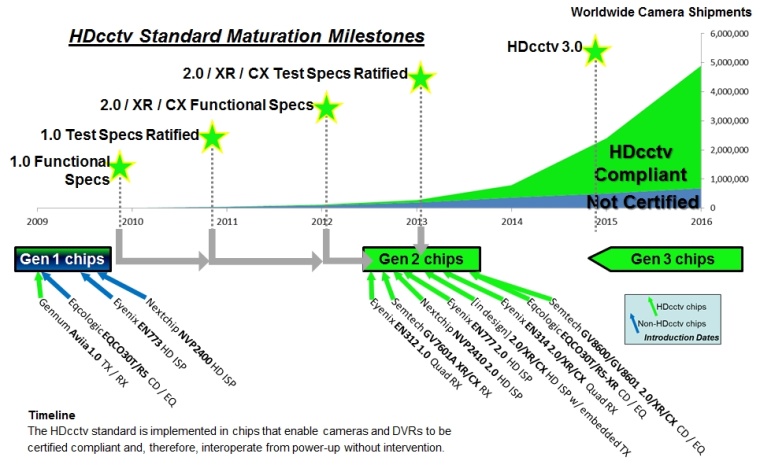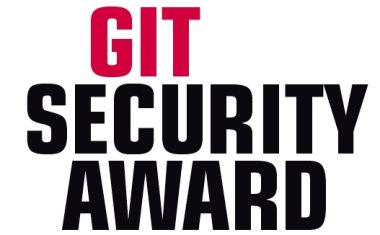Surveillance Equipment Chip Makers Invest US$30m in HDcctv Compliance
HDcctv Alliance chip-maker Member companies commit more than US$30m to deliver chips for HDcctvcompliant surveillance equipment in the coming year.HD surveillance equipment industr...

HDcctv Alliance chip-maker Member companies commit more than US$30m to deliver chips for HDcctvcompliant surveillance equipment in the coming year.
HD surveillance equipment industry association, the HDcctv Alliance, today announced that four of its industry-leading semiconductor Member companies have committed more than thirty million US dollars towards the development, manufacture, and marketing of chips that will enable HDcctv-compliant equipment.
HDcctv camera and DVR sales have grown from no units sold in 2009 to over 150K units sold in 2012. Continued growth demands 100% multi-vendor interoperability, which HDcctv compliance certification ensures. EqcoLogic, Eyenix, Nextchip, and Semtech today revealed the rollout timeline for ten newly designed chips for cameras and DVRs that will facilitate HDcctv compliance certification. These chips, scheduled to be in the hands of CCTV equipment designers in 2013, will make it more likely that HD surveillance equipment can be certified HDcctv compliant and will interoperate freely out of the box.
Availability of chips implementing the HDcctv standard accelerates the HD surveillance market
Conventional CCTV systems are designed by security installers, who mix and match surveillance products made by various manufacturers. Time spent adjusting cameras and DVRs to begin capturing video is part of an installer’s costs. If HDcctv cameras and DVRs do not work together straight out of the box, the installer’s costs go up. HDcctv compliance ensures that products from various manufacturers will interoperate upon power-up. Compliance certification is important to installers and manufacturers alike. For installers, the compliance mark in a product brief means plug-and-play, which holds down costs. For manufacturers and their OEM customers, compliance certification means fewer no-fault-found returns, which increases profit.
The timeline suggests that the impact of the HDcctv standard should become visible in the surveillance camera market during 2013. To be certified HDcctv compliant and eliminate any doubts about transmission performance and interoperability, a camera or DVR must implement certain functions. Because the chips that power today’s HDcctv products were designed before the HDcctv 1.0 standard had been defined, they did not necessarily have the functions embedded that are required for compliance certification.
This means that a large proportion of Generation 1 HDcctv cameras cannot be certified compliant. HDcctv equipment buyers will benefit from Generation 2 HDcctv chips implementing the functions needed for compliance certification. The ten Generation 2 semiconductor products listed in the timeline represent a total investment in chip design, semiconductor manufacturing ramp, and customer assistance that exceeds thirty million U.S. dollars.
Quotes from Companies
"Early on, we delivered chips that made it easy for development teams to migrate CCTV cameras and DVRs to high definition, but it took three years for most of the world’s CCTV equipment factories to produce at least one Generation 1 HDcctv model,” observed Don Shaver, Semtech marketing director.
“As a founder and Steering Member of the HDcctv Alliance, Semtech has led the HDcctv standard definition process. Semtech’s GV7601A is the industry’s first fully integrated receiver that implements extended reach (XR) capability. GV7601A and other Generation 2 products targeting HDcctv compliance will impact the end market more quickly than Generation 1 products have, because security installers are seeing the simplicity of HDcctv and have experienced high-quality HDcctv live views for themselves.” “We recognized the potential for the HDcctv market very early,” commented Hweihn Chung, Nextchip R&D director.
“Too early, in that we weren’t able to provide for HDcctv compliance in NVP2400. We are excited that our NVP2410 chip (‘Eagle2’) – already on our customers’ lab benches – can implement pathological test pattern generation, CRC, StreamID, and so forth. This means Eagle2-based HDcctv cameras will pass all HDcctv compliance tests, provided that the camera-internal electrical pathways are implemented correctly.” “Interoperability among manufacturers’ equipment is essential for the HD surveillance market to reach its growth potential,” observed Peter Helfet, CEO of EqcoLogic.
“EqcoLogic has a track record of leading the development of standards, and we are proud to make a significant technical contribution to the HDcctv 2.0 physical layer definition. As the surveillance market continues to migrate to HD, we anticipate widespread adoption of our QCO30T/R5-XR chips, and we are committed to enabling interoperability of all our customers’ HDcctv products.”
“Eyenix is proud to support the HDcctv Alliance. Standards compliance means an out-of-the-box plug-andplay customer experience, which, in turn, drives sales,” said Dr. Jon Hwang, CEO of Eyenix. “In addition to providing for camera compliance certification in our EN777 chip, Eyenix is excited to offer a multi-channel receiver ASIC chip for HDcctv-compliant DVRs. Our investors see enormous potential for HDcctv semiconductor sales.”
“Security customers care about colour reproduction, sensitivity, sharpness, dynamic range, privacy masking, ease of use, and so on,” commented Todd Rockoff, executive director of the HDcctv Alliance.
“Local-site video transport technology becomes a direct concern to customers only when it creates problems such as arise from non-interoperability,” he continued.
“An equipment executive’s first reflex is to differentiate his products from those of the other manufacturers. The Alliance’s mission is to encourage competitors to overcome that reflex and cooperate when it comes to device interface technology. We’re working to help makers’ executives appreciate that everyone – customers, installers, and competing manufacturers alike – benefits from the interoperability that HDcctv compliance certification ensures.”













